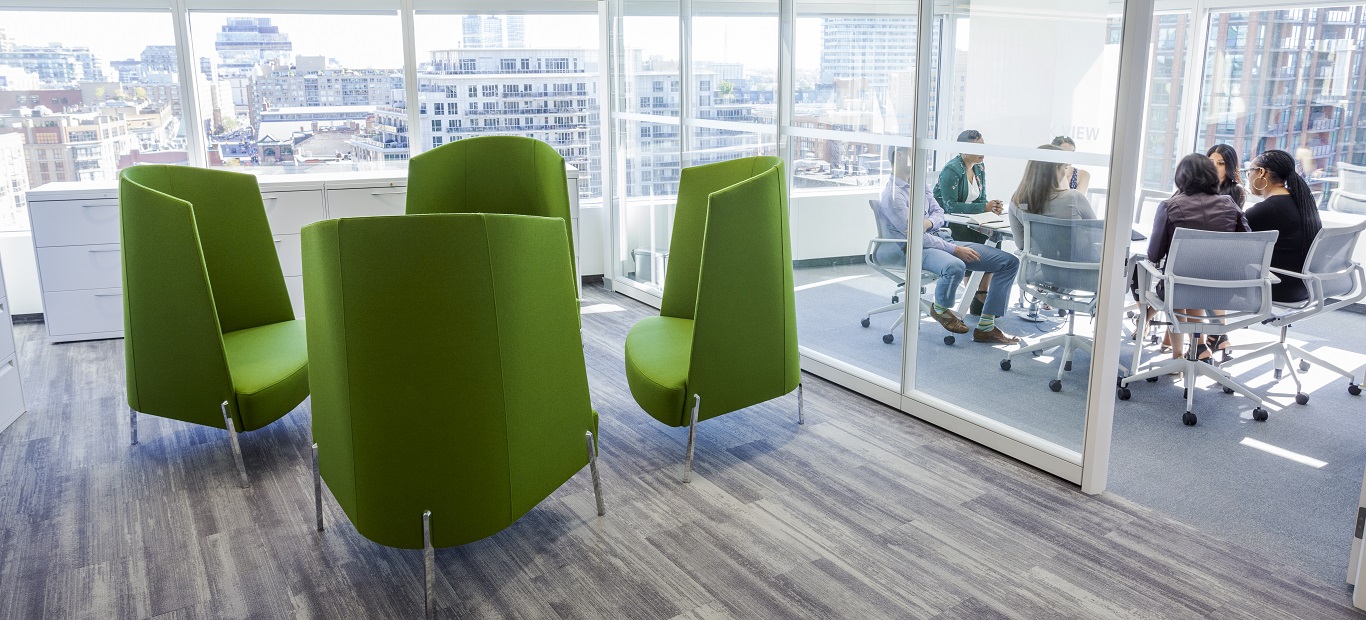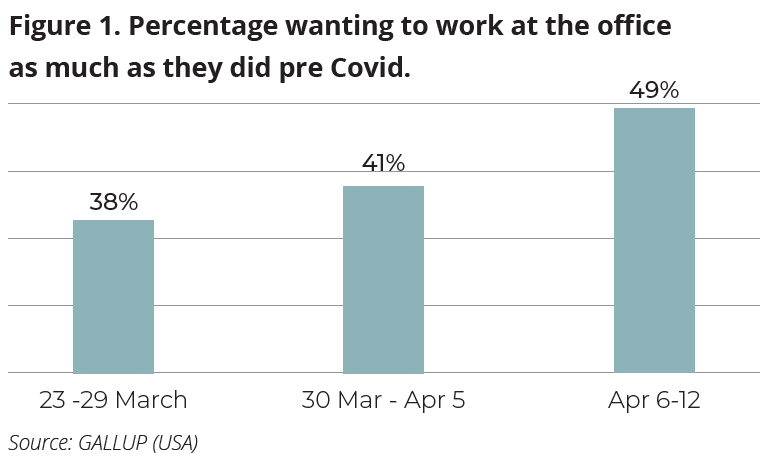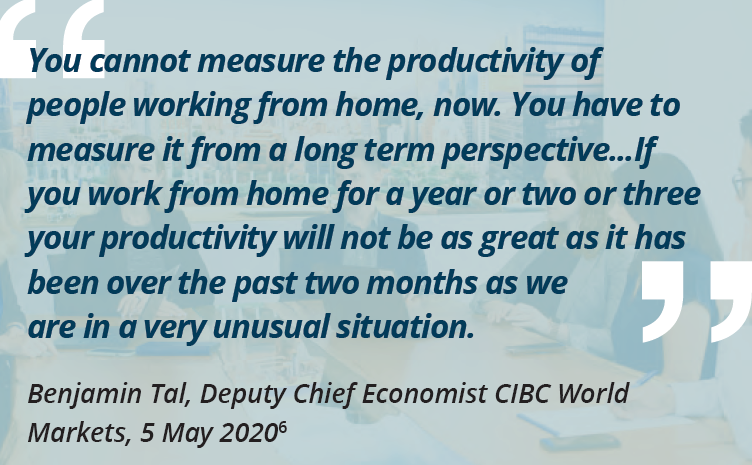
Office Space Plays a Key Role in Productivity
The work from home response to COVID has generated significant dialogue about the future of office demand long term. While some perspectives are that remote work will dramatically reduce office needs, evidence suggests these concerns are overstated.
True, millions of office workers globally have managed to complete essential work from home, to the delight of employers. It is also true that most employees have found positive aspects to working from home, such as spending more time with family or avoiding a tiresome traffic-snarled commute.
Challenges with working at home
But some preliminary evidence suggests the majority have not achieved the same level of productivity nor job satisfaction. Those who are managing or exceeding their normal workflows are often working much longer hours (at least 3 additional hours in the US, for example), which is likely not sustainable long term.1 Moreover, exhaustion from video-meetings--aka “zoom calls”--and struggles with isolation have gradually eroded many office workers’ contentment.2
As Figure 1 shows, according to Gallup, as this forced work-from-home experiment drags on, US office workers have steadily become more interested in returning the office as much as ever.3 Only 38% wanted to return to the office after approximately week two of being at home; by week four 49% were ready to return to the office full time (Gallup has not published updates since). And this doesn’t include those wanting a modest amount of work-from home time, a balance. Global real estate firm JLL, in a survey of their own office workers, found that only 5% wanted to work from home full-time post-Covid.
For most office workers, now remote-work-enabled, it is likely not an “either/or” question. Most will welcome opportunities to work from home while also valuing their time at the office. And employers are also appreciating the benefits of both. Corenet, an organization of facilities managers, reported that 66% of their members now have a more favourable view of remote working, suggesting this experiment has proven to many employers that some office workers’ tasks can get done effectively outside the office.4

The Value of The Office – Inspiration, Long-Term Productivity
A few CEOs as well as market watchers have suggested office space is no longer needed because their firm’s productivity has increased in recent weeks, in their view. However, this observation reflects only a short window of time. Moreover, they are typically fixated on only one aspect of what office workers do—focused work such as generating reports, designs or software code. But office space is for much more than that, especially among those employers considered “best places to work.” Office spaces are places where people interact in formal and informal ways, generating ideas, creating connections, learning skills, and transferring wisdom between generations. It’s where the inspiration comes from for that “focused work” productivity.
Cushman and Wakefield in a recent webinar notes that office productivity—while hard to measure precisely—includes five key areas.5 At different times of their days and weeks, office workers must be able to:
- Focus
- Collaborate
- Have refresh opportunities (breaks that refresh)
- Create social bonds with colleagues
- Learn in formal and informal ways, continuously (mentoring, watching colleagues is as important as course work)
Focused work can often be done effectively at home, assuming the individual does not need access to confidential paper documents or specialty technology or systems. The other aspects of 21st century office work are more efficient and effective at the office. Yes, you can take breaks at home, however it is not the same. A coffee break at the office, for example, might involve a walk to get a coffee with colleagues, whether in the kitchen or at a café, and this also provides an opportunity to forge social bonds, learn something new, and may ignite an idea. A “break” at home might involve unloading the dishwasher or putting in a load of laundry (neither inspiring nor refreshing.)
The pandemic-induced distancing has taught everyone how to use Microsoft Teams and Zoom, among other technologies, which can substitute for some face-to-face connections. Everyone has also learned how exhausting these meetings can be, and how carefully planned they are. Serendipitous encounters around the water cooler or in the kitchen simply don’t happen.

As Benjamin Tal (Deputy Chief Economist, CIBC Capital Markets) stated in a recent webinar address, office productivity needs to be measured over months and years. Over the past nine weeks, office workers have been able to draw on connections built with colleagues over the previous months, years, and in some cases decades. Many had already done the creative collaboration required to go home and write reports or code. Those bonds with colleagues and the inspiration to complete work will gradually diminish without those chance encounters as well as regular in-person conversations, presentations, and problem-solving sessions.
Closing thoughts on the need for office space:
- Long-term organizational performance and success depends on: building trust among colleagues; creating confidence in leaders; collaborating on projects; transferring knowledge between people, and even building a culture or brand. And this needs to happen in formal meetings as well as informal encounters. This takes place in office space.
- Office professionals want to be productive and successful—and their employers also want them to succeed. This requires the opportunity to do everything listed in #1 above, which requires office space. Prior to the covid-19 outbreak, most firms were competing for talent. The talent is typically 80-90% of company costs while office space is 5-10% of costs (with technology being most of the remainder). If the office space can make the talent more productive and improve attraction and retention, the financial math works.
- Some of the talent will want to work from home when appropriate, and we anticipate employers will embrace this more post-pandemic. However, to ensure all employees remain connected, collaborating and sharing, most will also need to have a place in the office.
GWLRA Research continues to monitor statements and decisions by office users as well as the productivity levels of Canada’s office worker community. We will produce additional Research Notes as new information becomes available.
[1] Michelle F Davis and Jeff Green, “Three Hours Longer, the Pandemic Workday Has Obliterated Work-Life Balance,” Bloomberg.Com, 23 April 2020. https://www.bloomberg.com/news/articles/2020-04-23/working-from-home-in-covid-era-means-three-more-hours-on-the-job
[2] Manju Jiang, “The reason Zoom Calls drain your energy,” BBC 22 April 2020, accessed at: https://www.bbc.com/worklife/article/20200421-why-zoom-video-chats-are-so-exhausting
[3] Jim Harter, “How Coronavirus Will Change the ‘Next Normal’ Workplace,” Gallup.com, 1 May 2020 https://www.gallup.com/workplace/309620/coronavirus-change-next-normal-workplace.aspx
[4] Corenet Global. (14 April 2020) Corporate Real Estate Professionals: Employees will return inwaves, not all at once; social distancing and other measures will continue at the office.
[Press Release] Retreived From: https://www.corenetglobal.org/stayinformed/newsdetail.
aspx?ItemNumber=43022
[5] Recovery Readiness: A How-To Guide for Reopening Your Workplace, 22 April 2020. https://www.cushmanwakefield.com/en/insights/covid-19/recovery-readiness-webinar-replay-april-2020
[6] Informa Canada, “Top-Rated Economist Addresses Growing Impact of Covid 19”, 5 May 2020, https://event.on24.com/wcc/r/2283829/AFF9A9C9BD85EA991D70BFD1C6628D79

Leading the national Research and Strategy team, Wendy’s responsibilities include providing economic, demographic and market-trends analysis to support long-term asset acquisition, development and management strategies. Wendy has been working in real estate research since 2002, including over a decade with GWL Realty Advisors. She holds a Ph.D. in comparative-world and economic history from the University of Arizona.